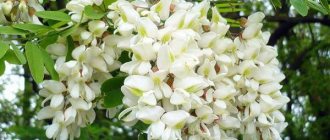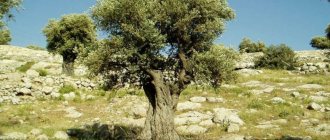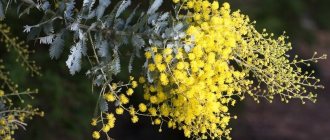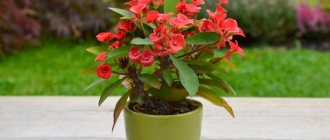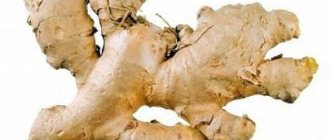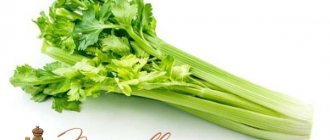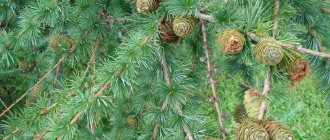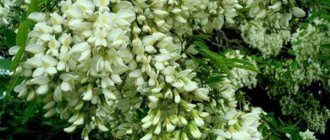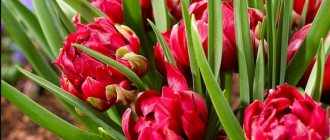Many gardeners like to decorate their plots with spreading and flowering trees. One of them is Acacia. The aroma of its flowers spreads over long distances and intensifies at night, attracting insects. The name "Acacia" has two origins. One of them is Greek – meaning “sharp”, the other Egyptian – meaning “thorn”. More than 1,300 species of acacia are known, most of them do not have thorns.
Botanical description
It belongs to an evergreen tree species that reaches a length of 25 meters. The trunk diameter reaches 1.2 meters. Some of them grow as shrubs.
Acacia leaves have a pinnate shape, are located alternately or whorled on the branches, but are numerous. Sometimes the leaves are replaced by needle-shaped, lanceolate or widely grown cuttings.
Acacia blooms in inflorescences forming panicles or clusters. They bear flowers of yellow, cream or white color. The bell-shaped calyx contains 5 petals. The flower whorl is yellow or white, tubular in shape, with 4-5 wings.
The shrub belongs to the legume family, so after flowering its fruits have the shape of an oblong pod. In different species, the shape and characteristics of the pod differ from each other (large, straight, curved, flat, cylindrical, opening and closed).
Many plants often have thorns, especially those that grow in the south. The tree has a strong root system. The main root goes deep, the rest branch in the surface layers of the earth. The bark of the tree has a silvery color and turns brown as it grows.
Pink and Crimean varieties. Mimosa
Pink acacia is distinguished by lush flowering. The name of the tree was determined by the bright flowers. At the same time, the characteristic aroma from them is barely perceptible. In the southern regions with early spring, pink acacia can bloom twice - in April and in September. Normally this period falls in May. Other features:
- height - 7-12 m;
- crown - wide;
- bark - brown, smooth;
Pink
- leaves are long, complex in structure, rich green;
- The spines are large, white, but soft to the touch.
Attention! The pink variety is called the most unpretentious in the family. The tree copes with both summer heat and temperatures dropping to -30°C.
Silver acacia is an evergreen crop. It is well known under the name mimosa. The homeland of the plant is Australia. This is associated with a growing season that is not quite typical for the northern hemisphere. Therefore, mimosa is cultivated in the southern regions: the Caucasus, Central Asia, and the Mediterranean coast.
Other characteristics:
- The crown forms a spreading umbrella. It consists of long feather-like carved leaves.
- Grows up to 10-12 m. The trunk is covered with smooth gray-brown bark.
- This type of acacia blooms in February and lasts about a month. The tree throws out inflorescences - densely filled panicles of bright yellow pompoms (0.5-0.8 mm in diameter).
Mimosa
Crimean (silk) acacia or Lankaran albizia is beautiful with openwork foliage. This property gives greenery an abundance of thin white veins. At night the leaves curl up. The Crimean variety also blooms in an original way. The fluffy flowers consist of many thin petals and resemble dandelions, only colored pink or scarlet. During the flowering phase, the tree emits a pleasant smell. The maximum height of the plant is 12 m. It is quite demanding in terms of care. The crop is grown on dry soils with plenty of sunlight. It is not suitable for cool northern regions.
Kinds
Many types of acacia are used by gardeners and lovers of creative landscape design. The most popular varieties are:
- Acacia Farnesiana. A shrub growing in areas of the Black Sea coast, 2-4 meters high. The bark is brown with a silver tint. The branches seem to be broken, and many of them show slight pubescence. The leaves are pinnate, divided into 2-8 branches.
- Acacia Podalyriifolia. The height of an adult plant is 5 meters. It can take the form of a bush, then it grows no higher than 3 meters. Dense small leaves are green with a silver-gray tint. The shrub blooms from January to April. Many golden-yellow flowers emit a long-lasting fragrant scent. Southern acacia does not tolerate air temperatures below 10 °C.
- Magnificent acacia (Acacia spectabilis). An adult plant varies in height from 1.5 to 4 meters. The flowers are bright yellow and bloom from July to November. The green foliage has a silvery tint and is feathery in shape. The fruits of the tree are large, in the form of pods up to 18 cm in size. The southern variety of the tree does not tolerate low temperatures (not lower than 8 ° C). But it is patient with heat up to 35 °C and prolonged drought.
- Red acacia (Acacia oxycedrus). The name comes from the word “beautiful”. A small shrub (up to 2 meters) is strewn with pale yellow flowers, collected in groups of up to 3 pieces. Flowering occurs from July to November. Thanks to large and strong roots that go deep into the earth, the tree can easily withstand drought.
- Long-leaved acacia (Acacia longifolia). In 5 years it can grow up to 10 meters. A southern tree with long, stiff, dark green leaves. Pale yellow inflorescences form catkins. Australia and the USA are considered to be their homeland. Cultivated in the subtropics. Used to prevent soil erosion. Yellow and green dyes are produced from flowers and leaves.
There are many other interesting species of this tree. Such as: Bordered (Acacia anceps), Veinless (Acacia aneura), Leafless (Acacia aphylla), Ashby (Acacia ashbyae), Varied-thorned (Acacia ataxacantha), Bailey (Acacia baileyana) and others.
There are trees that are popularly called acacias, although they belong to a different genus. These are Yellow Acacia or Caragana Arboréscens with bright yellow flowers collected in clusters and White Acacia or Robinia Pseudoacácia with white fragrant flowers. These varieties are frost-resistant and grow under natural conditions in our country in the middle and southern zone.
White acacia
This species is called Robinia false acacia. Its homeland is North America. But for a long time this type of plant has successfully settled in central Russia. Now this is no longer an outlandish tree, and every child knows what acacia is. The following trees are planted:
- To strengthen the soil.
- For wind protection purposes.
- As a decoration for the area.
The wood of the plant is elastic and does not crack, is easy to polish and boasts:
- strength;
- resistance to rotting;
- beautiful structure and color.
During flowering, the crown of the tree becomes white, as if covered with snow. There are a lot of flowers. Some herbalists collect them for herbarium. Thanks to the abundance of essential oil in Robinia flowers, perfumers can create wonderful scents. Flowers are also used for medicinal purposes.
Seeds are collected in winter or at the very beginning of spring, but it is worth keeping in mind that acacia beans are poisonous.
Acacia wood is good for heating a room, as it burns well and produces a lot of heat.
Planting and care
Spring time is the most favorable time for planting acacia. In the southern regions this can be done in the fall. It is recommended to transplant cuttings from containers to well-lit places.
You need to dig a hole 50 cm deep and wide. Then fill in a drainage layer of sand, about 10 cm. The tree will need support at first, so you need to install it. Next, the roots need to be placed in the planting hole, straightened out and sprinkled with loose soil mixed with nitroammophoska fertilizer. Water the plant.
The shrub will only need care for the first 2 years of its life. Then, it will only need to be trimmed, forming the desired crown. It is worth considering that the roots of the plant do not like close proximity, so planting flowers around the tree is not recommended. It is advisable to promptly remove weeds and loosen the soil.
An adult plant needs watering only in cases where there has been no rain for more than 2-3 months. Young bushes are watered as the soil dries to speed up growth. Fertilizer feeding will be needed only three years after planting and, accordingly, the first application.
Excerpt characterizing Acacia longifolia
- Lovely, divine. Her eyes (Nikolai looked at his interlocutor) are blue, her mouth is coral, whiteness... - he looked at her shoulders, - Diana's figure... The husband approached them and gloomily asked his wife what she was talking about. - A! Nikita Ivanovich,” said Nikolai, standing up politely. And, as if wanting Nikita Ivanovich to take part in his jokes, he began to tell him his intention to kidnap a certain blonde. The husband smiled gloomily, the wife cheerfully. The good governor's wife approached them with a disapproving look. “Anna Ignatievna wants to see you, Nicolas,” she said, pronouncing the words in such a voice: Anna Ignatievna, that it now became clear to Rostov that Anna Ignatievna is a very important lady. - Let's go, Nicholas. After all, you allowed me to call you that? - Oh yes, ma tante. Who is this? – Anna Ignatievna Malvintseva. She heard about you from her niece, how you saved her... Can you guess?.. – I never saved them there! - said Nikolai. - Her niece, Princess Bolkonskaya. She is here in Voronezh with her aunt. Wow! how he blushed! What, or?.. - And I didn’t think, completeness, ma tante. - Well, okay, okay. ABOUT! what are you! The governor's wife led him to a tall and very fat old woman in a blue cape, who had just finished her card game with the most important persons in the city. This was Malvintseva, Princess Marya's maternal aunt, a rich childless widow who always lived in Voronezh. She stood paying for the cards when Rostov approached her. She narrowed her eyes sternly and importantly, looked at him and continued to scold the general who had won against her. “I’m very glad, my dear,” she said, holding out her hand to him. - You are welcome to me. After talking about Princess Marya and her late father, whom Malvintseva apparently did not love, and asking about what Nikolai knew about Prince Andrei, who also apparently did not enjoy her favors, the important old woman let him go, repeating the invitation to be with her.
Reproduction
It can be propagated by both seeds and cuttings. The shelf life of seeds is up to two years. It is quite difficult to grow a tree from them yourself, so it is better to order or buy cuttings.
Propagating acacia by seeds will require some effort. In order for them to rise well, you need to steam them in very hot water, the temperature of which should be at least 80 ° C. The seed shell must be carefully cut. This procedure will speed up the germination process.
It is much easier to propagate the plant from cuttings. Stems or root shoots are suitable for this. The stem is cut 10 cm long from the middle of the shoot. This is done in the spring. One of the ends must be treated with a root stimulator and planted in a container that is placed in a greenhouse with a temperature of at least 22 ° C. You can plant it in a permanent place of growth in the fall.
To plant a root cutting, you will need to dig up part of an adult shrub in the spring. The root is divided into stems approximately 15 cm long and at least 5 mm in diameter. Roots in sandy soil on a slope. In autumn it can be transplanted into open ground.
Acacia at home
Robinia, as a vigorous tree, with a spreading crown, is clearly not suitable for indoor cultivation, but it is quite possible to grow silver acacia in a flower pot: in 2-3 years you will get a 60 cm bush, capable of flowering.
Seeds that have previously undergone scarification (sequential exposure to boiling water and 12-hour soaking in cold water) are quite suitable for propagation.
, stability of positive temperatures (+25°C), humidity not lower than 60% and a high agricultural background are important
Caragana is an open ground plant, and Lankaran silk acacia can be grown in a spacious room or greenhouse. To successfully complete such an experiment, several conditions are important:
- sufficient illumination with diffused light;
- comfortable temperature within 20-25°C;
- drainage soil in a large diameter pot;
- two watering modes (for summer and winter) without drying out the coma.
Indoor cultivation of deciduous trees is associated with the natural loss of leaves in winter. The plant will atone for its seasonal unsightliness with the luxury of its flowering phase. You should know that indoor cultivation of albizia is contraindicated for allergy sufferers.
- Final advice:
- For Robinia and Acacia, as fast-growing plants, pruning the root shoots when forming a trunk is important.
- All plants of this species require sanitary pruning at the beginning and end of the vegetative cycle.
- Gardeners recommend pruning silver acacia after flowering at the inflorescence level.
- Indoor crops are more demanding on the agricultural background, but very patient and inquisitive people take on their cultivation.
Diseases and pests
If the maintenance conditions are normal, the tree may never get sick. But there are insect pests that can harm a healthy plant. They damage leaves, shoots, branches and trunks of shrubs. You can get rid of them by removing them manually or using chemicals by spraying.
Sometimes acacia leaves turn yellow and dry out. This happens when a tree is affected by a fungal disease. Caused by the fungus Septoria caraganae (Jacz.) Died. A diseased bush stops blooming and loses its foliage. Affected branches and leaves must be cut off, then spray the bush with Bordeaux mixture.
Meaning and Application
Acacia has not only decorative qualities. It is widely used by people in everyday life:
- The decorative nature of some species attracts gardeners. It is used to decorate the garden interior or grown in large pots at home.
- The weaving type is used as a hedge for summer cottages and country houses.
- Thanks to its strong and branched root system, the shrub can serve as a fortification for slopes and ravines.
- Beekeepers like to plant the tree in the apiary area, framing the apiary meadows with it. Acacia honey is tasty and healthy.
- Flowers, leaves and bark are used in folk medicine. Flowers are collected in late May - early June and dried. A decoction of them is used as prescribed by a doctor for migraines, myositis, osteochondrosis, to improve immunity, etc.
- Acacia wood is very dense, but bends well, so it is used for making doors, exclusive interior items and parquet. Due to the high density of the material, cutting it is quite difficult, but there are craftsmen who create wonderful souvenirs and jewelry from this wood.
Use in landscape design
Decorative varieties of acacia are widely used in landscape design. To decorate the garden, choose low plants with abundant flowering. In order to enclose an area with a hedge, Acacia variegata is suitable. Its thorns will not allow you to overcome the fence, and its ability to curl will close it as tightly as possible.
Silver Acacia, which ordinary people often confuse with mimosa, looks great in a garden or park. It looks equally good either alone or in a group with other plants.
To form arches or arbors, white or yellow acacia is most often used. Thanks to its flexibility and creeping ability, it beautifully weaves around free space, and clusters of fragrant flowers hang from the branches. Such a tree is easy to shape to obtain the desired weave.
